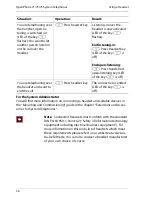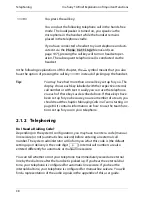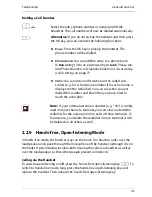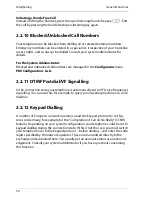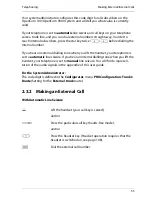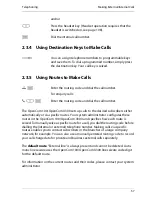
Telephoning
General Functions
46
2.2.2 Signalling on the Call Keys
The LEDs and symbols on the call keys indicate the following states:
2.2.3 Calls in the Call-waiting Queue
The system administrator can configure and activate a
call-waiting queue
espe-
cially for your telephone in the OpenCom 100/OpenCom X300 system. While you
are making a call, new calls can be queued. These callers first hear an
announcement (if the system administrator has preset an announcement) and
then the ring tone. The number of calls permitted in the call-waiting queue is set
by the system administrator during system configuration, 5 calls for example.
When this number is reached, further callers hear the busy tone. The calls in the
queue are put through in order of priority (baby calls, door calls, VIP calls, other
internal and external calls), irrespective of the order in which they came in.
Calls that have been in the queue for too long are removed, and the callers then
hear the busy tone. The period of time until a call is released is set by the network
operator. In Germany this is usually two minutes and in other European countries
usually three minutes.
Your telephone can have a call-waiting queue even if it belongs to a subscriber
group, where it simultaneously affects call forwarding.
First call
LED flashes rapidly
Bell is displayed
Further call
LED flashes rapidly
Bell is displayed
Further call,
call-waiting queue is full
Short beep tone
(only on the OpenPhone 75)
Key seized
LED on
Arrow is displayed
Call held
LED flashes slowly
Arrow is displayed
Team member’s key is seized
LED on
Handset and team key text are dis-
played
Summary of Contents for OpenPhone 73
Page 1: ...OpenPhone 71 73 75 on the Communications Systems OpenCom 100 and OpenCom X300 User Guide ...
Page 8: ...6 ...
Page 136: ...Index 134 Notes ...
Page 137: ...Index 135 Notes ...
Page 138: ...Index 136 Notes ...
Page 139: ......





